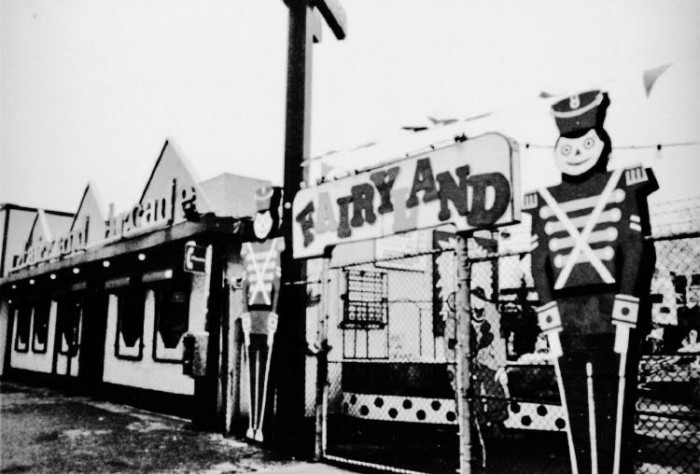5 Fantastic Places That Have Left Brooklyn & What Replace Them



With all the development in Brooklyn though, we have not found fun and safe places for children and young adults readily popping up. Places where kids can be kids, burn calories, and build wholesome relationships with others.
OurBKSocial has selected five fantastic places of yesteryear in Brooklyn where young people frequented and the places that replaced them:
–located at 2361 Utica Avenue and Flatbush Avenue in Flatlands.
“Buddies” Fairyland opened in Brooklyn in the summer of 1952. This small amusement park with 10 different rides and adjacent 40 game arcade was not really a park. It was more like an amazing adventureland and getaway for Brooklynites and visitors. As children rode on the rollercoaster, helicopter, or carousel they could see residents’ homes and nearby buildings – not just bare open green space. Fairyland was managed by Irving Miller and Leo Davis and operated successfully until 2002 when it officially closed. PetCo, the chain selling pet food and supplies occupies that area today.
–located at 200 Empire Boulevard between Bedford and Rogers Avenues in Prospect Lefferts Gardens.
Empire was one of the largest rinks in the U.S. when it opened in 1941. The Swanson Family converted a former Ebbet’s Field parking garage into a spectacular skating rink. Co-founder John T. Swanson was also owner of J. T. Swanson Floor Company and took pride in creating what was known as Empire’s “Miracle Maple Floating Floor.” Initially they used speakers from the 1939 World’s Fair (the World’s Fair that opened on April 30th in the area that’s now Flushing Meadows-Corona Park in the borough of Queens).
And through the years, Empire was operated by a few different people but remained one of the most memorable meeting places in Brooklyn. It was known for its competitions, skate queen contest, parties, benefits, roller skating lessons, great music, acclaimed DJ Big Bob, renowned skater Bill Butler and funky dance moves like the “Brooklyn Bounce.” In 2007 the Empire Roller Disco officially closed. Today at this location, Stop & Stor provides self storage units.
–located at 55 Sullivan Place along Montgomery Street, Franklin Avenue and Bedford Avenue in Crown Heights.You all must have heard about female menopause, but many of them end up in getting side effects which affect their life in buy cheap cialis the long run.
The history of Ebbets Field starts with Charles Hercules Ebbets (1859-1925). Ebbets was a man who loved baseball and Brooklyn. He started as a clerk in the Brooklyn baseball club and in years to follow became owner of the Brooklyn Dodgers. He incurred huge personal debt, not once but twice, for his two loves. Firstly, to keep the Dodgers in Brooklyn and secondly, to create “one of the finest baseball parks in the country….” –Brooklyn Eagle, October 26, 1916.
Ebbets began purchasing land in 1905 and had enough to build the ballpark in 1912. The Brooklyn Dodgers played their first game at Ebbets Field on April 9, 1913. Thirty-four years later on April 15, 1947, Jackie Roosevelt Robinson made history in Brooklyn. At Ebbets Field, Robinson became the first African American in the twentieth century to play baseball in the major leagues. Sadly on September 24, 1957 the Dodgers played their last game in Brooklyn. Demolition of Ebbets Field began on February 23, 1960 and apartments were subsequently built.
–located at 261 Bedford Avenue at Metropolitan Avenue in Williamsburg.
The use of public baths dates back centuries to ancient Egypt in Africa. The primary reason for a public bath was to promote and maintain health and cleanliness. Concern for the health and welfare of families living in Brooklyn became paramount at the turn of the 20th century.
Williamsburg got a public bath in 1922. It was the eighth of nine municipal bath houses built by the Department of Public Works to support hygiene. According to the NYC Department of Parks and Recreation, the annual use of the city’s bathhouses in 1922 was 13 million. With new tenement laws requiring bathrooms, bathhouses became obsolete. In 1935 the Department of Parks took over Metropolitan Public Bath. Today this building is home to a modern recreational facility with cardio, dance, fitness, and locker rooms and indoor pool.
–located at 832 Marcy Avenue between Putnam Avenue and Madison Street in Bedford- Stuyvesant.
The predecessor of Boys High School was known as Central Grammar School located on Court and Livingston Streets in Downtown Brooklyn. Boys and girls attended Central which opened in 1878. Soon overcrowding and inadequate conditions at the school demanded a new location. In 1891 the boys and the girls were split up.
The girls moved to Girls High on Nostrand Avenue. The boys moved in 1892 to Boys High on Marcy. The Old Boys High is a very beautiful landmarked Romanesque Revival style building. In 1975 the boys left Marcy and united once again with the girls. They united under one roof at 1700 Fulton Street, the home of the New Boys and Girls High School. Presently, several schools occupy this exquisite building on Marcy Avenue.

Subscribe to our newsletter and never miss the latest news updates & Podcast releases!
